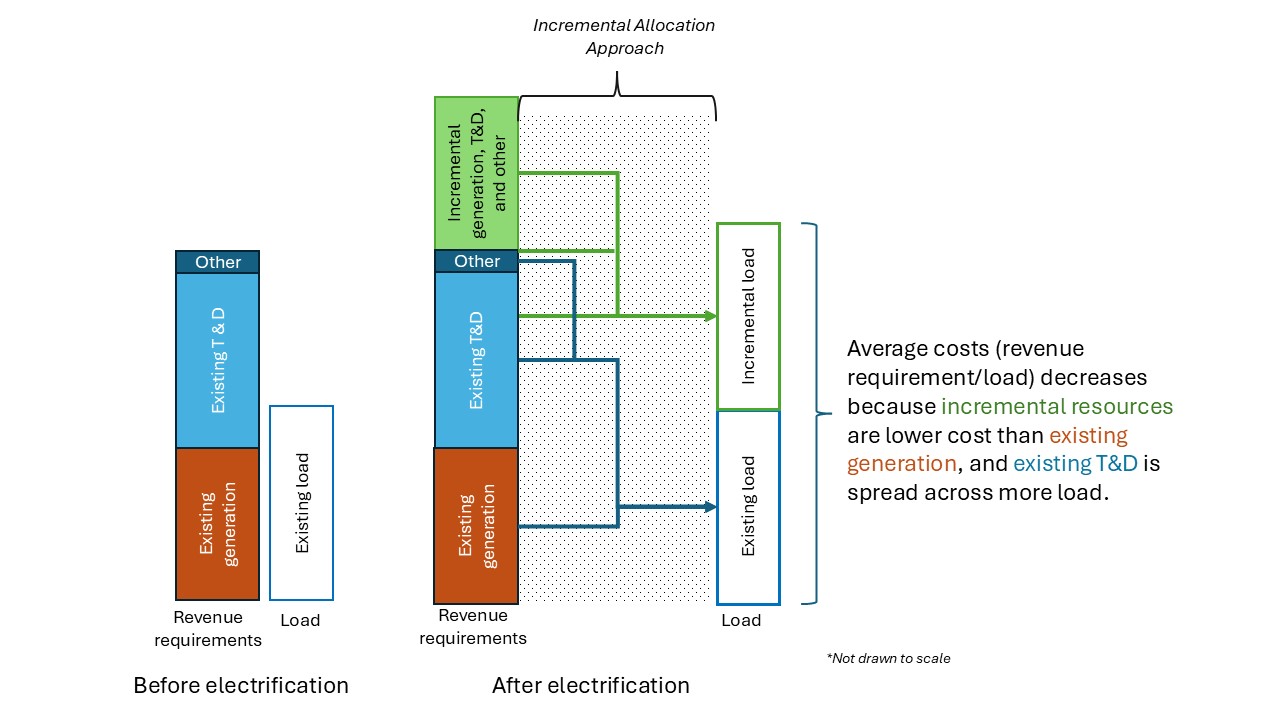
Smart Cost Allocation: The Secret Ingredient to Affordable Electricity in a New Era of Load Growth
RMI’s Optimus tool can help design cost allocation solutions to support affordability during rapid load growth.
The idea that electric load growth can lower rates for everyone is nothing new. The logic is simple: load growth allows for higher utilization of the electricity grid’s existing assets (such as transmission and distribution), which dilutes their fixed costs. Those efficiency gains offset upward pressure on rates coming from new investments to meet load growth. However, ongoing analyses from RMI show that we can take advantage of even stronger drivers and levers to make electricity more affordable as demand grows.
In most places, clean resources today are lower cost than current generation. So, adding them to the grid to meet new, incremental load growth can lower the average cost to meet overall electricity demand thereby making the system more cost-effective on a dollar-per-megawatt-hour basis. This has the potential to drive down rates and benefit even those utility customers who don’t buy EVs or electrify their home.
However, low-cost renewables alone do not guarantee this outcome; they need to be accompanied by thoughtful cost allocation approaches. Optimus, RMI’s financial modeling tool, has new cost allocation functionality that can help ratemaking practitioners reveal opportunities for win-win solutions that can meet the growing demands of the evolving grid while improving affordability for everyday customers.
The problem
The United States is coming into a new period of load growth driven by the electrification of homes and vehicles and the rise of data centers. The need to deploy incremental investments across generation, transmission, and distribution systems is causing widespread concern that electricity bills will increase for everyone. While we’ve handled load growth in the past, this period is coming in the middle of an energy affordability crisis. If load growth isn’t leveraged to make electricity more affordable for all customers, particularly low- and moderate-income customers, it could worsen the energy burden of the people who are not capable of accessing electrification technologies to reap their benefits. Keeping rates low will also make electrification technologies easier to access.
Leveraging cost allocation to find win-win solutions
Electrification-driven load growth will require new investments leading to rising costs, but how we allocate those costs will determine whose costs will rise and by how much. Using Optimus, our analysis used utility-reported data, technical expert reports, and NREL technology costs from an amalgamation of representative utilities to create an illustrative utility system for which we could run different scenarios that inform our insights.
This analysis isn’t the first to suggest the idea that load growth can lower rates for everyone. While most refer to the increased utilization of the transmission and distribution (T&D) grid as the driver of lower costs, our analysis finds that the win-win solutions happen when the incremental set of resources (including generation, transmission, and distribution) meet new load at a lower average cost than existing grid resources. This creates a win-win by providing lower-cost electricity for most ratepayers while unsticking progress toward electrification and allowing those who electrify to reap the benefits of lower electric rates, lower home fuel costs, more modern technology, lower non-electric costs, and better health.
Win-win outcomes do not just happen automatically — intentional cost allocation is the key that opens the door. Cost allocation involves allocating approved, prudently incurred costs to customer classes. It is the key step in the ratemaking process to determine who pays for what, by apportioning and assigning the costs and benefits of load growth. Different cost allocation approaches offer multiple ways to balance these costs and benefits; allowing everyone to benefit while meeting regulatory and policy goals related to load growth. Or, if done poorly, force customers who don’t benefit from electrification to pay the costs of investments needed to support it.
For example, incremental generation investments and T&D upgrades to meet new loads means more costs need to be recovered. But if more incremental generation can come from low-cost clean resources, the costs of T&D upgrades may be offset, and the resulting average unit costs will be lower. In RMI’s analysis, average electricity costs can decrease by up to 15 percent by 2032, compared to 2024 levels, for our illustrative utility. Distributing most of the new costs that need to be recovered to the new or electrifying customers, while most of the unit cost savings are distributed to all ratepayers, can allow for an electricity price that maintains (or even improves) the attractiveness of electrification technologies while reducing the electricity bills of those who cannot yet afford those investments.

For our illustrative utility, load (MWh) increases 27 percent by 2032 but costs (in dollars) only rise 8 percent over that same period. This leads to 15 percent lower average prices ($/MWh) than today. In 2040, load rises by 45 percent and costs rise more sharply, 40 percent, leading to 3 percent lower average prices than today.
Real world applications
The RMI team, with tools like Optimus, can help industry stakeholders navigate cost allocation and pass along savings to ratepayers. This effort generally involves two steps, depending on the context:
Step 1: Checking if the conditions are right for a win-win scenario
As noted above, two conditions need to be true for a win-win to be possible. The first one is finding an incremental portfolio with a total unit cost that is lower than the average unit cost of the existing system. When there’s a risk of lumpy or costly T&D upgrades, there are solutions like VPPs, non-wires alternatives, and grid-enhancing technologies to achieve this enabling condition. RMI can also help explore approaches to cost control to help put downward pressure on new costs.
The second condition is making sure that cost allocation approaches and processes are set up such that they allow for ways to spread out costs and benefits. RMI can help assess whether these conditions are met, and provide strategic advice on regulatory incentives that need to be created or changed to support these conditions.
Step 2: Running the cost allocation math
To make sure the benefits show up in customers’ bills, cost allocation strategies that assign new resources to new loads using a differential treatment need to be designed, assessed, and implemented. If opportunities for a win-win exist, RMI can help conduct quantitative analysis with tools like Optimus to identify innovative cost allocation strategies that align with state policy, advance regulatory priorities, and maintain affordability.
If you are interested in RMI’s support to explore win-win solutions via cost allocation, please contact us.
Additional technical and editorial support was provided by RMI’s Optimus Team: Becky Li, and Jeffrey Sward.